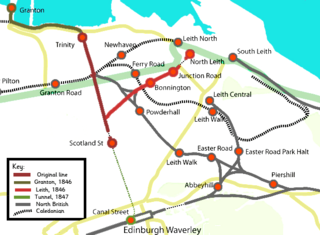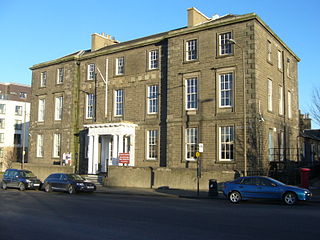
The Firth of Forth is the estuary, or firth, of several Scottish rivers including the River Forth. It meets the North Sea with Fife on the north coast and Lothian on the south.

North Queensferry is a village in Fife, Scotland, situated on the Firth of Forth where the Forth Bridge, the Forth Road Bridge, and the Queensferry Crossing all meet the Fife coast, some 10 miles from the centre of Edinburgh. It is the southernmost settlement in Fife. The prefix North serves to distinguish it from South Queensferry, on the opposite shore of the Forth. Both towns derive their name from the ferry service established by Queen Margaret in the 11th century, which continued to operate at the town until 1964, when the Road Bridge was opened.

Queensferry, also called South Queensferry or simply "The Ferry", is a town to the west of Edinburgh, Scotland. Traditionally a royal burgh of West Lothian, it is administered by the City of Edinburgh council area. It lies ten miles to the north-west of Edinburgh city centre, on the shore of the Firth of Forth between the Forth Bridge, Forth Road Bridge and the Queensferry Crossing. The prefix South serves to distinguish it from North Queensferry, on the opposite shore of the Forth. Both towns derive their name from the ferry service established by Queen Margaret in the 11th century, which continued to operate at the town until 1964, when the Road Bridge was opened.

The River Forth is a major river in central Scotland, 47 km (29 mi) long, which drains into the North Sea on the east coast of the country. Its drainage basin covers much of Stirlingshire in Scotland's Central Belt. The Gaelic name for the upper reach of the river, above Stirling, is Abhainn Dubh, meaning "black river". The name for the river below the tidal reach is Uisge For.

Granton is a district in the north of Edinburgh, Scotland. Granton forms part of Edinburgh's waterfront along the Firth of Forth and is, historically, an industrial area having a large harbour. Granton is part of Edinburgh's large scale waterfront regeneration programme.

Historically, Scotland has a long military tradition that predates the Act of Union with England. Its soldiers form part of the armed forces of the United Kingdom, more usually referred to domestically within Britain as the British Armed Forces.
HMS Lochinvar was a minesweeping training "stone frigate" of the Royal Navy, sited at Port Edgar on the Firth of Forth. It was established in 1939. From 1943 to 1946 it was temporarily transferred to nearby Granton Harbour while Port Edgar became a training centre for the 1944 Normandy Landings. HMS Lochinvar closed in 1975 when its operations moved across the Forth to HMS Caledonia in the rebuilt naval base at Rosyth.
The Edinburgh and Northern Railway was a railway company authorised in 1845 to connect Edinburgh to both Perth and Dundee. It relied on ferry crossings of the Firth of Forth and the Firth of Tay, but despite those disadvantages it proved extremely successful. It took over a short railway on the southern shore of the Forth giving a direct connection to Edinburgh, and it changed its name to the Edinburgh, Perth and Dundee Railway.
Six ships and one depot of the Royal Navy have borne the name HMS Columbine, after the common name for the plant Aquilegia. A seventh ship was planned, but renamed before being launched:

The Edinburgh, Leith and Newhaven Railway was a railway company formed in 1836 to connect the city of Edinburgh with the harbours on the Firth of Forth. When the line connected to Granton, the company name was changed to the Edinburgh, Leith and Granton Railway. It opened part of its route in 1846, but reaching the centre of Edinburgh involved the difficult construction of a long tunnel; this was opened in 1847. It was on a steep incline and was worked by rope haulage.
One ship, and two shore establishments, of the Royal Navy have borne the name HMS Lochinvar:

HMS Claverhouse was a shore establishment of the British Royal Navy, based at Granton, Edinburgh. It is a listed building, used as a training centre for E Squadron, 205 (Scottish) Field Hospital (Volunteers).
The Firth of Forth was historically crossed by ferry until the opening of the Forth Road Bridge in 1964.

Trinity Chain Pier, originally called Trinity Pier of Suspension, was built in Trinity, Edinburgh, Scotland in 1821. The pier was designed by Samuel Brown, a pioneer of chains and suspension bridges. It was intended to serve ferry traffic on the routes between Edinburgh and the smaller ports around the Firth of Forth, and was built during a time of rapid technological advance. It was well used for its original purpose for less than twenty years before traffic was attracted to newly developed nearby ports, and it was mainly used for most of its life for sea bathing. It was destroyed by a storm in 1898; a building at the shore end survives, much reconstructed, as a pub and restaurant called the Old Chain Pier.
The Dunfermline and Queensferry Railway was a railway company founded to form part of a rail and ferry route between Dunfermline and Edinburgh, in Scotland. It was authorised in 1873 and its promoters had obtained informal promises from the larger North British Railway that the NBR would provide financial help, and also operate the ferry and the necessary railway on the southern side of the Firth of Forth.
HMSAS Bloemfontein was an Algerine-class minesweeper built for the Royal Navy in Canada during World War II. The ship was originally named Rosamund and spent several years clearing minefields in Europe after she was completed in 1945 before she was placed in reserve. Rosamund was purchased by South Africa in 1947 and later renamed HMSAS Bloemfontein.

PS Duchess of Fife was a paddle steamer built in 1903 for the Caledonian Steam Packet Company. She spent most of her career serving passenger routes in the Firth of Clyde and was requisitioned for use as a minesweeper during both World Wars. In 1940 she took part in the Dunkirk evacuation, rescuing a total of 1,633 allied troops.
In 1989 the Royal Navy was under the direction of the Navy Department in the UK Ministry of Defence. It had two main commands, CINCFLEET and Naval Home Command.
Commander Ernest Claude Shankland RNR FRSE was a 19th-century Scottish naval officer and harbour expert.

The University Royal Naval Unit East Scotland is one of 17 University Royal Naval Units and a Royal Navy training establishment based in Scotland, accepting roughly 65 Officer Cadets from universities in Edinburgh, Fife and the Tayside region. It is one of the University Service Units and is under the command of Britannia Royal Naval College, Dartmouth. The unit's affiliated P2000 ship is HMS Archer, which is predominantly used for training Officer Cadets.




















